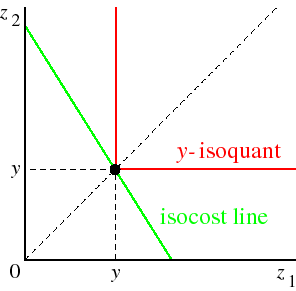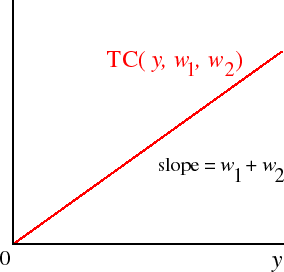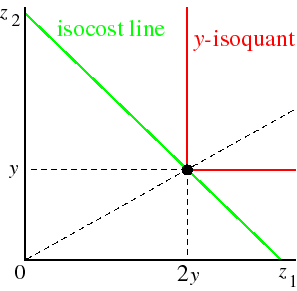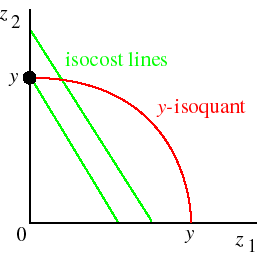2.3 The cost function for a firm with two variable inputs
Consider a firm that uses two inputs and has the production function F. This firm minimizes its cost of producing any given output y if it chooses the pair (z1, z2) of inputs to solve the problem
Denote the amounts of the two inputs that solve this problem by z*1(y, w1, w2) and z*2(y, w1, w2). The functions z*1 and z*2 are the firm's conditional input demand functions. (They are conditional on the output y, which is taken as given.)
The firm's minimal cost of producing the output y is w1z*1(y,w1, w2) + w2z*2(y,w1, w2) (the value of its total cost for the values of z1 and z2 that minimize that cost). The function TC defined by
(Note that the hard part of the problem is finding the conditional input demands; once you have found these, then finding the cost function is simply a matter of adding the conditional input demands together together with the weights w1 and w2.)
Graphical illustration of the cost-minimization problem
The firm's cost-minimization problem is illustrated in the following figure. The red curve is the y-isoquant: the set of all pairs (z1, z2) of inputs that produce exactly the output y. The light blue area, above the y-isoquant, is the set of all pairs (z1, z2) of inputs that produce at least the output y: the set of feasible input bundles for the output y. Each green line is a set of pairs (z1, z2) of inputs that are equally costly: an isocost line. The points on any given isocost line satisfy the condition
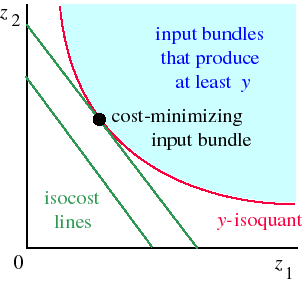
The cost-minimization problem of the firm is to choose an input bundle (z1, z2) feasible for the output y that costs as little as possible. In terms of the figure, a cost-minimizing input bundle is a point on the y-isoquant that is on the lowest possible isocost line. Put differently, a cost-minimizing input bundle must satisfy two conditions:
- it is on the y-isoquant
- no other point on the y-isoquant is on a lower isocost line.
Another example of a firm's cost-minimization problem is given in the following figure. In this case the isoquant is bowed out from the origin. The cost-minimizing bundle is, as before, the bundle on the isoquant that is on the lowest possible isocost curve. This bundle is indicated by the large black dot. (Note that the point at which an isocost line is tangent to the isoquant maximizes the cost of producing the output y along the isoquant.)
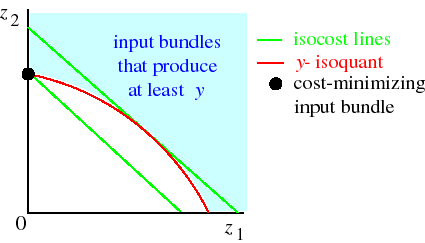
The case of smooth isoquants convex to the origin
If the y-isoquant is smooth and the cost-minimizing bundle involves a positive amount of each input, as in the first figure, we can see that at a cost-minimizing input bundle an isocost line is tangent to the y-isoquant.Now, the equation of an isocost line is
If the isoquants are smooth and convex to the origin and the cost-minimizing input bundle (z1, z2) involves a positive amount of each input, then this bundle satisfies the following two conditions:
- (z1, z2) is on the y-isoquant (i.e. F(z1, z2) = y) and
- the MTRS at (z1, z2) is w1/w2 (i.e. MRTS(z1, z2) = w1/w2).
The condition that the MRTS be equal to w1/w2 can be given the following intuitive interpretation. We know that the MRTS is equal to MP1/MP2. So the condition that the MRTS be equal to w1/w2 is equivalent to the condition
- Example: production function with fixed proportions
-
Consider the fixed proportions production function F(z1, z2) = min{z1, z2} (one worker and one machine produce one unit of output). An isoquant and possible isocost line are shown in the following figure.
To produce y units, the firm wants to use y units of each input, no matter what the input prices are. Thus the conditional input demands are
z*1(y,w1,w2) = y and z*2(y,w1,w2) = y.Hence the total cost function isTC(y,w1,w2) = w1y + w2y = (w1 + w2)y.TC is shown as a function of y, for some fixed values of w1 and w2, in the following figure.
- Example: production function with fixed proportions
-
Consider the fixed proportions production function F(z1, z2) = min{z1/2,z2} (two workers and one machine produce one unit of output). An isoquant and possible isocost line are shown in the following figure.
To produce y units, the firm want to use 2y units of input 1 and y units of input 2, no matter what the input prices are. Thus the conditional input demands are
z*1(y,w1,w2) = 2y and z*2(y,w1,w2) = y.Hence total cost function isTC(y,w1,w2) = w1·2y + w2y = (2w1 + w2)y.For fixed values of w1 and w2, this function is linear in y, like the TC function for the previous example.
- Example: general production function with fixed proportions
-
Consider the general fixed proportions production function F(z1, z2) = min{az1, bz2}. To produce y units, the firm wants to use y/a units of input 1 and y/b units of
input 2, no matter what the input prices are. Thus the conditional input demands are
z*1(y,w1,w2) = y/a and z*2(y,w1,w2) = y/b.Hence total cost function isTC(y,w1,w2) = w1·(y/a) + w2(y/b) = y(w1/a + w2/b).For fixed values of w1 and w2, this function is linear in y, like the TC function for the previous example.
- Example: Cobb–Douglas production function
-
Consider the production function F(z1, z2) = z1/2
1z1/2
2. The isoquants of this function are smooth and convex to the origin, and for any input prices the firm optimally uses a positive amount of each input. Thus the conditional input demands satisfy the two conditionsy = z1/2and
1z1/2
2w1/w2 = MRTS.The second condition is equivalent tow1/w2 = z2/z1.Hence substituting for z2 in the first condition, we find that the conditional input demands satisfyy = ((w1/w2)z1)1/2·z1/2Isolating z1 and then substituting into the equation w1/w2 = z2/z1 to obtain z2, we conclude that the conditional input demands are
1 = (w1/w2))1/2z1.z1 = y(w2/w1)1/2 and z2 = y(w1/w2)1/2.Thus the total cost function is
TC(y,w1,w2) = w1y(w2/w1)1/2 + w2y(w1/w2)1/2 = 2y(w1w2)1/2.We see that once again TC is a linear function of output y, given the input prices z1 and z2.
- Example: production function in which inputs are perfect substitutes
-
Consider the production function F(z1, z2) = z1 + z2, in which the inputs are perfect substitutes. An isoquant and some isocost lines for the case in which w1 > w2 are shown in the following figure.
For such input prices, the optimal input bundle is (0,y): the firms uses only input 2. The reason is clear: the inputs may be substituted for one another one-for-one, so if the price of input 1 exceeds the price of input 2 then the firm uses only input 2. Similarly, if w1 < w2 then the firm uses only input 1: the optimal input bundle in this case is (y,0). Finally, if w1 = w2 then the isocost lines have the slope −1, the same as the isoquant. Thus the firm is indifferent about the input bundle it uses.
In summary, the conditional input demands are
z*1(y,w1,w2) = 
y if w1 < w2 [0, y] if w1 = w2 0 if w1 > w2 and
z*2(y,w1,w2) = 
0 if w1 < w2 [0, y] if w1 = w2 y if w1 > w2. Thus the total cost function is
TC(y,w1,w2) = 
w1y if w1 < w2 wy if w1 = w2 = w w2y if w1 > w2. As in the previous examples, for any fixed values of the input prices the total cost function is linear in output y.
- Example: production function with nonconvex isoquants
-
Suppose that the production function is F(z1, z2) = (z2
1 + z2
2)1/2. In this case the isoquants are quarter-circles. An isoquant and some isocost lines for a case in which w1 > w2 are shown in the following figure.We see that in this case the optimal input bundle is (0,y). If w1 < w2 then the optimal input bundle is (y,0), and if w1 = w2 then the both (0,y) and (y,0) are optimal, and no other bundles are optimal. Thus the conditional input demands are:
z*1(y,w1,w2) = 
y if w1 < w2 0 or y if w1 = w2 0 if w1 > w2 and
z*2(y,w1,w2) = 
0 if w1 < w2 0 or y if w1 = w2 y if w1 > w2. Thus the total cost function is
TC(y,w1,w2) = 
w1y if w1 < w2 wy if w1 = w2 = w w2y if w1 > w2. Once again, for given values of w1 and w2 the cost function is linear in output y.
